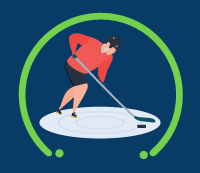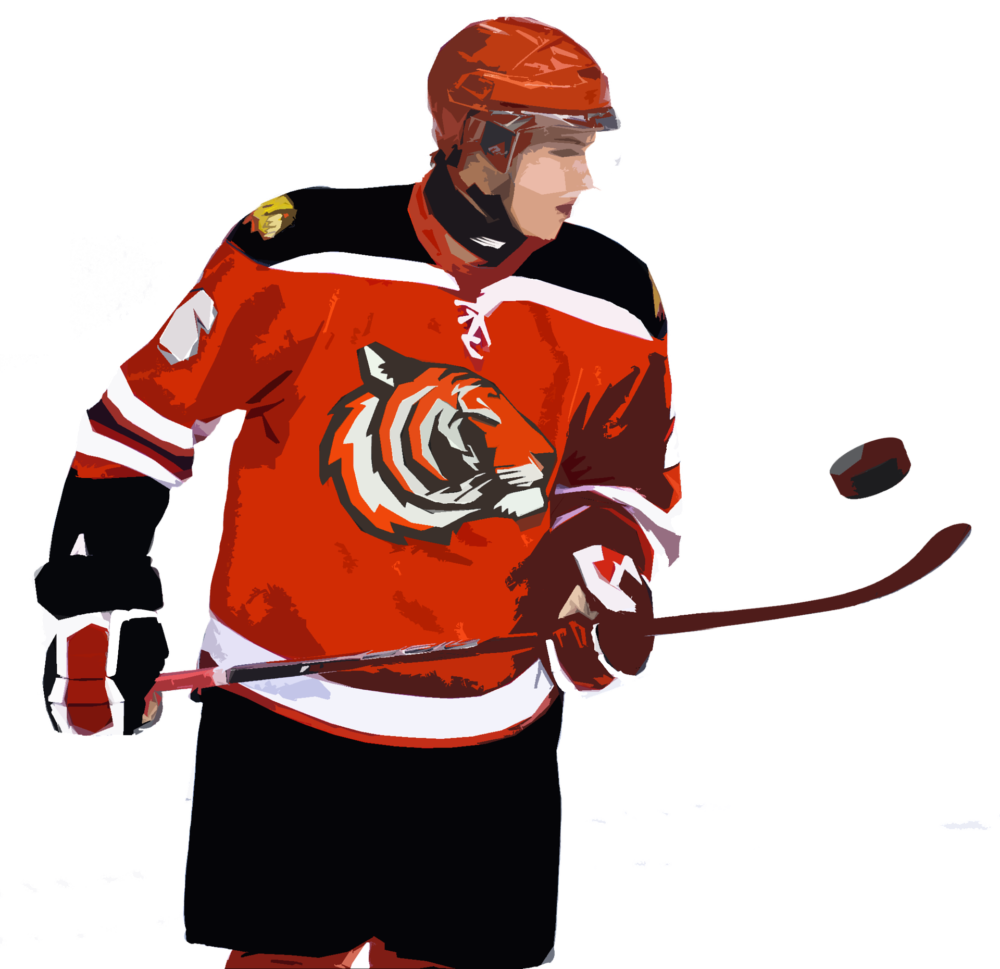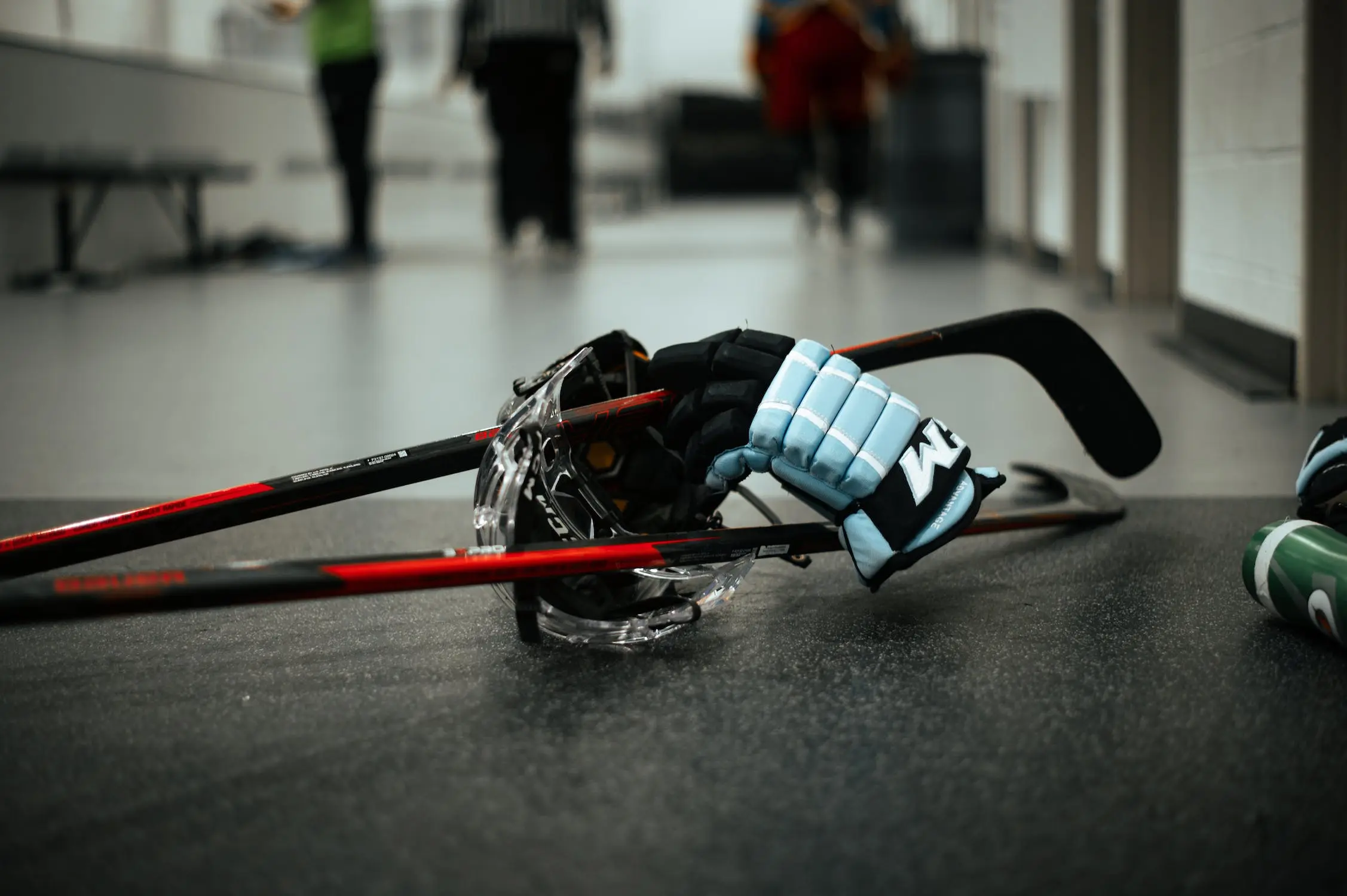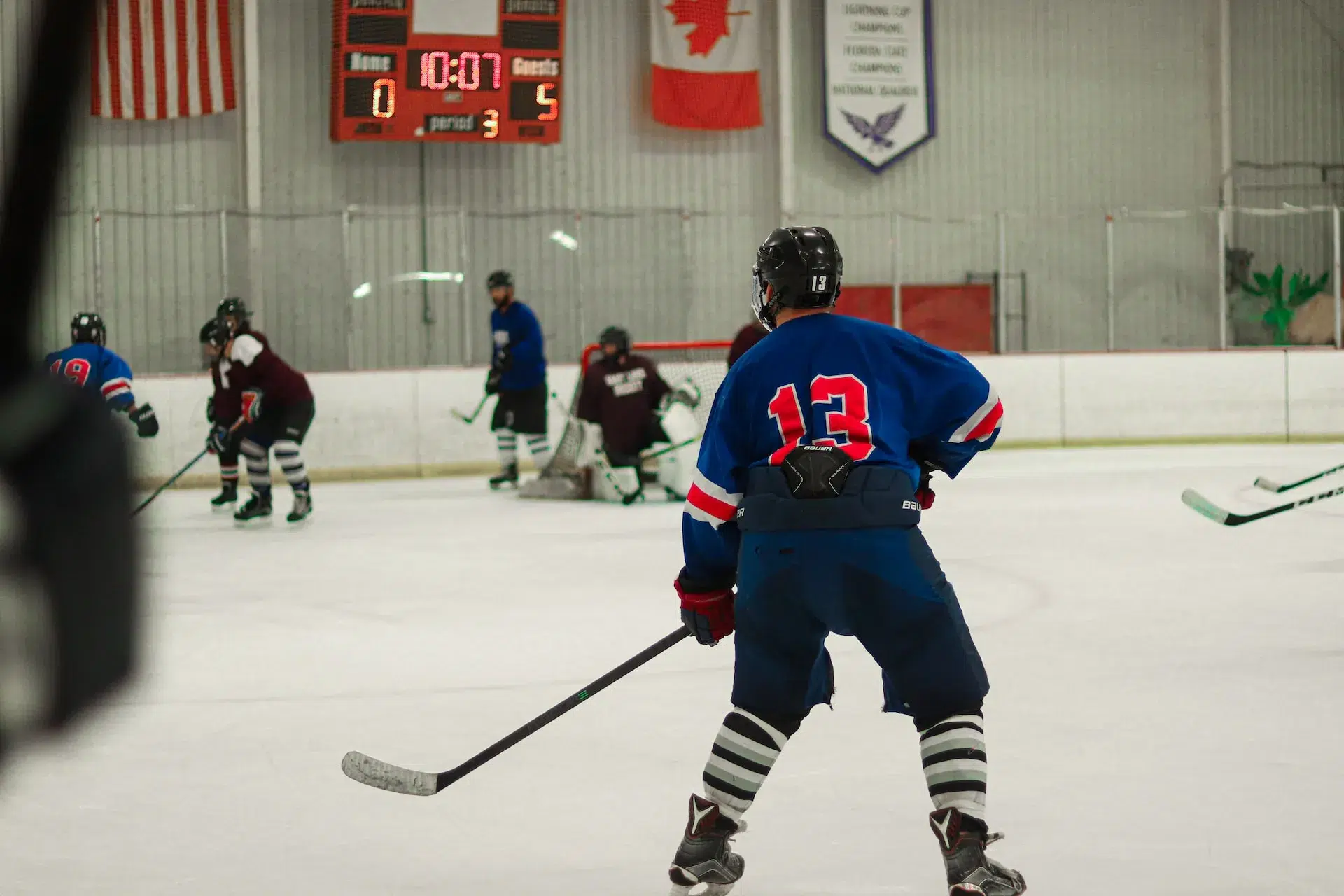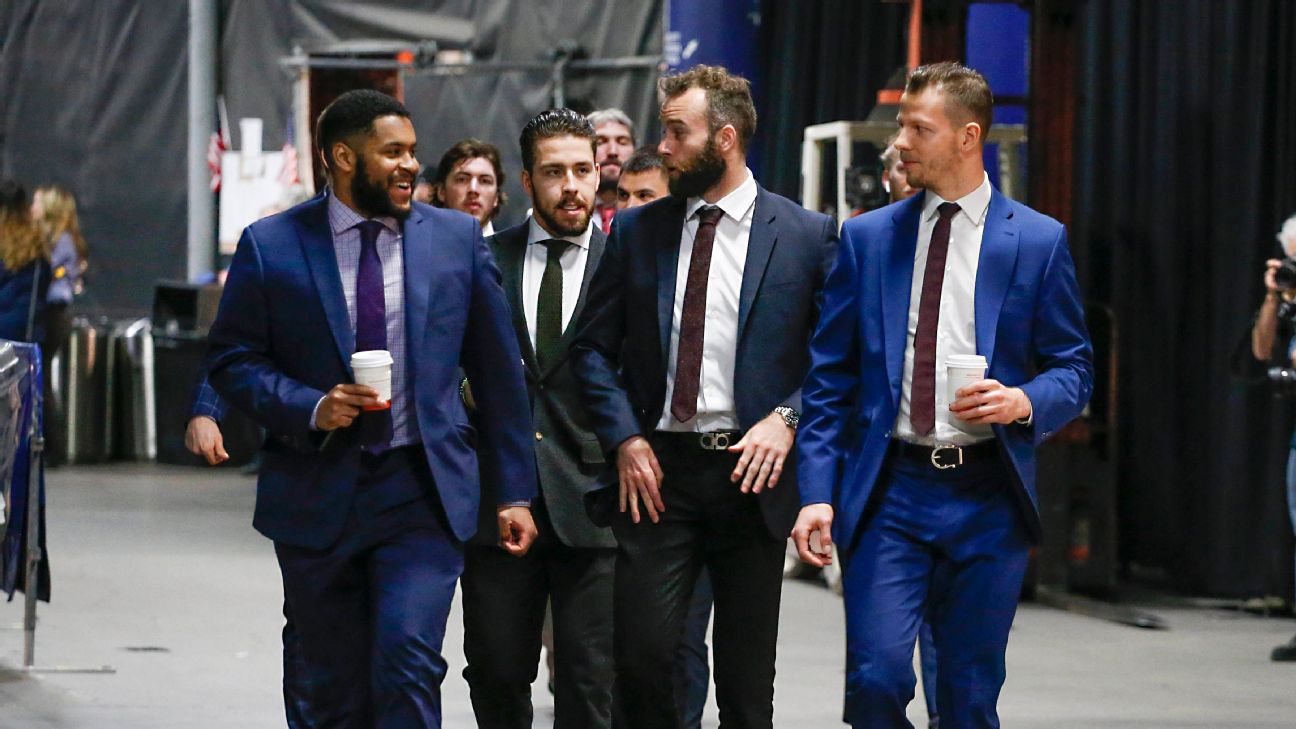Ice hockey is an exciting and fast-paced sport that requires endurance, speed, and skill. Whether you want to play recreationally or you want to fulfill your passion of becoming a successful ice hockey player, I will help you get started and show you everything that you need to know for beginning to play ice hockey.
Ice Hockey is a team sport played at the ice hockey rink with the markings and lines using ice skates, puck, and stick. This is among the sports featured in the winter Olympics. Its international competition is governed by the International Ice Hockey Federation (IIHF).
So, it was a brief introduction to Ice hockey and I will let you know some important aspects of ice hockey that you must know as a beginner to start playing hockey.
Equipment
Equipment includes two types of equipment one is safety items and the other is playing items. The safety items include mouthguards, shin pads, helmets, gloves, elbow pads, & others. The playing items include a puck, hockey sticks, skates, and more.
Explore more about hockey stick brands in our comprehensive guide.
Make sure your kit must fit you properly as it is crucial for your game. Equipment that fits you perfectly gives you more protection and makes you more comfortable and allows you to perform better.
As you begin your journey in ice hockey, it’s essential to invest in high-quality gear from the most trusted brands. Check out our comprehensive guide on the Top Hockey Brands You Need to Know about to help you make informed decisions when choosing the right equipment for your needs.
Following are the esstential equipments that you need to start playing , I would recommend you buy these items:
Skates
Comfortable and well-fitted ice hockey skates are very important and they will help you in enjoying the game while playing. The ideal fit is snug where your foot rests flat on the footbed.
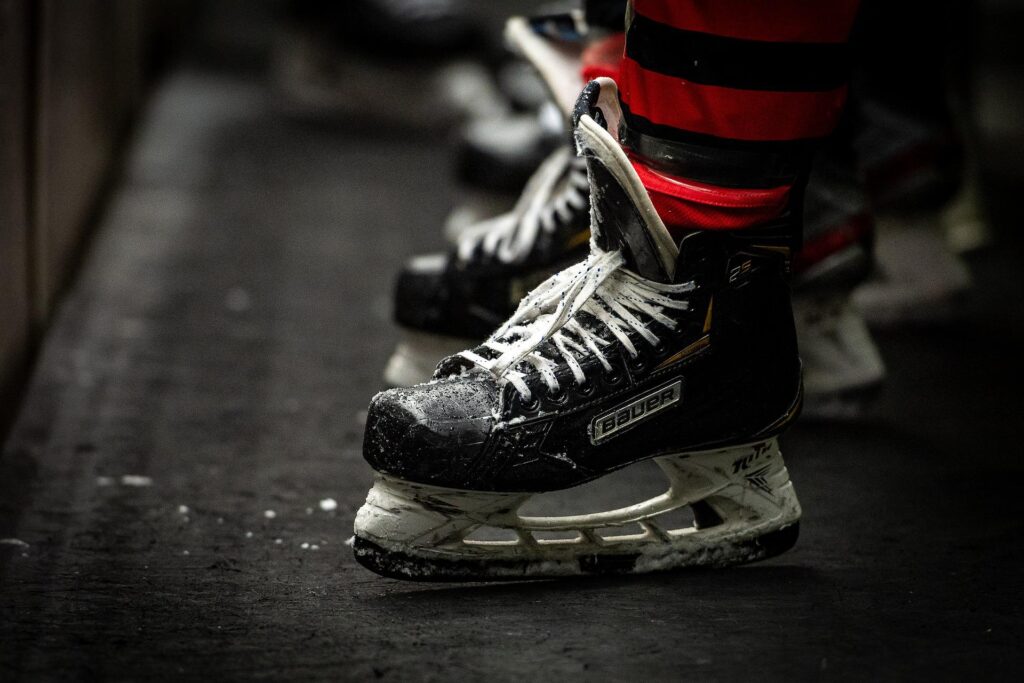
A too-big skate won’t offer you the best stability and will impact your skating performance and a too small skate will feel uncomfortable and cramped with each stride. A standard pair of skates will be found as a rookie until you find a permanent position in the team.
Understanding the intricate differences between various hockey skate brands and choosing the right one for your specific needs is vital for optimal performance. Explore our comprehensive guide on Hockey Skate Brands to discover the best brands in the market. For those unsure about the differences between hockey skates and figure skates, our detailed comparison of Hockey Skates vs. Figure Skates offers insights to make an informed decision.
Helmet
A helmet in ice hockey is a must for head protection. There are various types of hockey helmets available in the market. Your helmet should fit snugly without constricting the head, must cover at least half of your forehead, and secure enough so that the helmet shouldn’t wobble out of position. After getting the designated position, then the kit can be built up depending upon your position.
Before hitting the ice, it’s crucial to select the right protective gear – especially a high-quality hockey helmet. Explore our comprehensive guides on How to Buy a Hockey Helmet and Hockey Helmet Brands to ensure you find the perfect fit for your needs!
Goalie Equipments
A Goalie is a person who stands near the net and whose primary motive is to stop the puck from the opponent’s side along with helping his team. Following are the equipments used by a goalie:
- Stick
- Mask
- Chest protector
- Neck guard/throat protector
- Goalie jock
- Knee pads/thigh guards
- Leg pads
- Blocker
- Catching glove
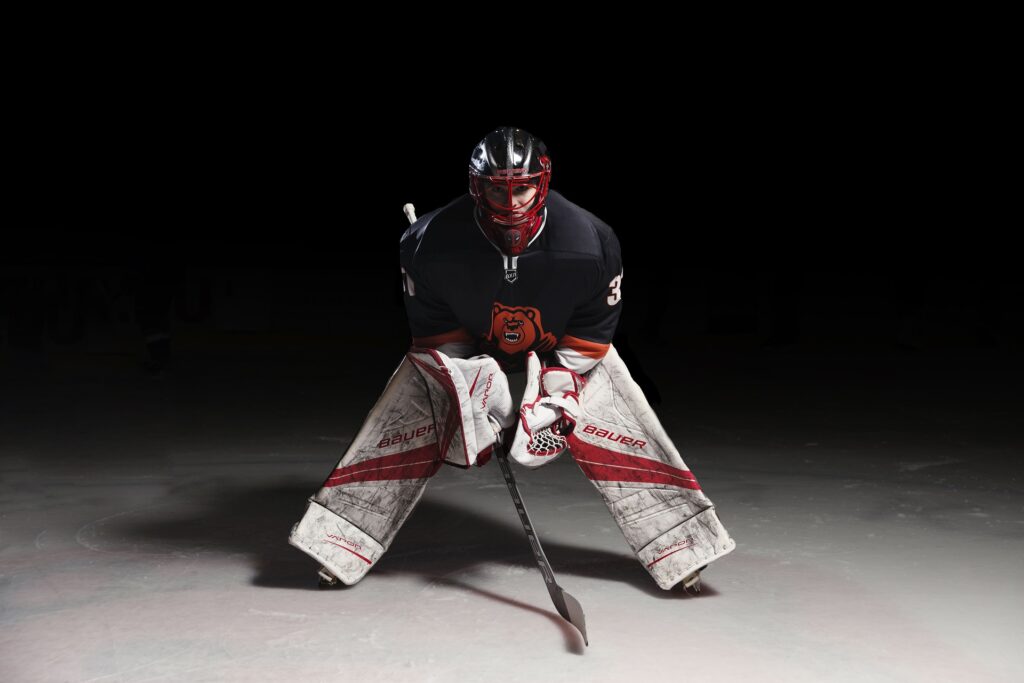
Player Equipments
The players in the Ice hockey team are two wingers left & right, two defensemen left & right, and one center beside the goalie. Following are the equipment used by the players:
- Stick
- Gum shield/mouth guard
- Neck guard
- Shoulder pads
- Elbow pads
- Shin guards
- Gloves
- Jock
Hockey Equipment by Position
| Position | Required Equipment | Additional Equipment |
|---|---|---|
| Goalie (Goaltender) | Helmet, chest protector, goalie pants, leg pads, blocker, catcher, stick, skates | Neck guard, throat protector, jock/jill, goalie mask with cage, goalie skates |
| Defenceman | Helmet, shoulder pads, elbow pads, gloves, shin guards, stick, skates | Mouthguard, visor/cage, protective cup |
| Forward (ice hockey) | Helmet, shoulder pads, elbow pads, gloves, shin guards, stick, skates | Mouthguard, visor/cage, protective cup |
| Referee | Helmet, whistle, striped jersey, pants, shin guards, elbow pads, gloves, skates | Mouthguard, visor/cage, protective cup, referee-specific equipment (e.g. armbands, penalty tracker) |
Do’s and Don’ts of equipment
- It is recommended when you start any new game, you must borrow equipment or buy a used kit until you decide that ice hockey is actually for you.
- While choosing hockey stick, choose it as per your height. If the stick is too short or too long, it will put unnecessary stress on your body.
- Initially, you will feel interfered with your mobility or uncomfortable with your new hockey gear. I would suggest you give yourself some time so that you get used to it and if it doesn’t work then look for alternatives. But make sure never to play without your protective kit because of the obvious reason for your safety.
- While lacing your skates use the crisscross method as it will provide you with good support and comfort. For allowing proper blood circulation, the bottom three eyelets should be semi-loose.
- Never wrap the laces of skates around your ankles as it will restrict your movement and ability to react quickly.
- Make sure your skates are snugly fit neither too loose nor too tight. They must provide you with good ankle support.
- Always keep all your hockey gear and equipment properly so that they don’t get harmed as it will give you more financial burden.
Are you interested in knowing more about the ice hockey equipment used by players and goalie? Then, read my guide on Ice Hockey Equipments and you will get a lot of information there.
Skills & Techniques
If you want to become a good hockey player, then you must possess the following skills in yourself:
Ice Hockey Skills by Position
| Position | Key Skills & Techniques |
|---|---|
| Goalie | Flexibility, quick reaction time, ability to read plays, strong lateral movement, and solid positioning. |
| Defense | Strong skating, good passing ability, solid stick work, ability to read the game, strong physical presence, and effective shot blocking. |
| Forward | Speed and agility, strong shooting ability, good puck handling skills, ability to create scoring opportunities, effective forechecking, and ability to play in tight spaces. |
| Center | Strong skating and puck handling skills, ability to win faceoffs, good vision and passing ability, and effective backchecking. |
| Winger | Strong skating and shooting abilities, ability to create scoring chances, effective board play, and ability to get open in the offensive zone. |
The most important hockey skills are skating, stopping, shootinghttps://icehockeyguide.com/hockey-shooting/, and passing. These are the basic skills that are learned by all the players before they start playing competitively.
It is extremely important to be a good skater in the game since skating and stopping are all about how to move on the ice. Passing and shooting are how you move the puck around and create the chances of scoring.
The most important attributes of a hockey player are strength, skating ability, and hand-eye coordination. Your success as a hockey player will become limited if you are not able to move quickly and easily on skates.
For fending off the checking attempts, strength is very important. For shooting and defensive attempts, hand-eye coordination must be perfect.
For getting perfect in your skills or for improving them, you need hockey drills. Drills are the things on which you must focus for becoming successful as a hockey player. Following are the hockey drills that one should always focus for improving the skills:
Key Ice Hockey Drills
| Drill Name | Description |
|---|---|
| Skating Drills | Exercises to improve forward, backward, crossover, and stopping skating techniques. |
| Passing Drills | Drills that improve passing accuracy, speed, and vision through various stationary and moving passing exercises. |
| Shooting Drills | Exercises that help players improve their shooting accuracy, power, and technique, including wrist shots, slapshots, and snap shots. |
| Defensive Drills | Drills that teach defensive skills such as stick checking, body positioning, and defensive zone coverage. |
| Offensive Drills | To improve puck handling, deking, shooting, and offensive zone positioning. |
| Power Play Drills | Drills to develop power play strategies, including passing, shooting, and movement patterns, zone entries, and faceoff plays. |
| Penalty Kill Drills | Drills to develop effective penalty kill strategies, including positioning, stick work, clearing the zone, and faceoff plays. |
- In passing drills, you will focus on basic passing, saucer passing, skating & passing, and star passing. In shooting, the focus will be on full ice horseshoes, accuracy, skating & shooting, and slapshots.
- In the hockey skating drills, the focus will be on forward & backward, superman, sharks & minnows, and circle skating.
- The stick handling drills will focus on in & out, 1-on-1 deke, and king of the hill. The transition drills will include big arc backchecking, full ice backcheck, shadowing, and Czech race.
- The defensive drills will include 1-on-1 along the boards, odd-man defensive coverage, and continuous breakout.
- All the drills and skills will be of no value if there Is no lack of teamwork and communication. In hockey, you might be playing as a winger or goalie or at a center or defenseman, but you are playing in and for a team.
- In other words, what you are doing will have a direct impact on your team. So, take care of your actions and words.
Whatever you are planning to do, share it with your teammates after all you have to make your team win. You can see many examples from history that lack of communication and teamwork has led to losing many big games & battles.
Ice hockey demands peak physical and mental performance from players. Read my guide to off-ice hockey training to learn how to increase your strength, speed, endurance, and cognitive agility.
Rules and Regulations
The main basic rules of hockey are icing, offside, faceoffs, and penalties. Le’ts go over them quickly.
Offside
When an attacking player enters the defensive zone before the puck, then the play is considered offside. Both the skates over the blue line will be considered as entering.
Icing
Icing in hockey occurs when any player on the side of the red center line of his team shoots the puck down the ice and it crosses the red line at any point. Icing is not permissible when teams are on the power play or at equal strength.
When this happens, the play is halted and the puck is returned to the other end of the ice for a face-off in the offending team’s zone.
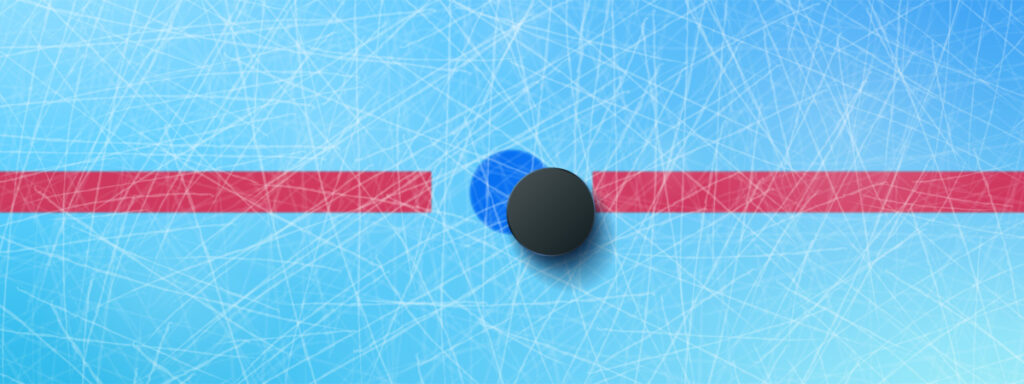
Faceoffs
Every play starts with a faceoff and ends after scoring a goal or when the referee blows the whistle.
Penalties
In hockey when you commit any mistake or penalty, you are sent to the penalty box. There are two types of penalties in hockey minor and major. Besides this, there is misconduct and match penalties.
A minor penalty is of two minutes and a major penalty can be from 5 or 10 minutes or a full match. When any penalty happens in the game, then the teams will either be on the power play or penalty kill.
If the other team commits a penalty, then they will be on the penalty kill and your team will be on the power play and vice versa.
Game Structure
Ice hockey games typically consist of three periods, each lasting 20 minutes of play time. The clock runs continuously, with stoppages only for penalties, goals, or time-outs. Between the first and second hockey periods, as well as the second and third periods, there is a 15-minute intermission.
Gain a broader perspective on how various elements combine to define the length of hockey games in our Hockey Game Length guide.
A series of red and blue lines are marked on the ice and this Is called a hockey rink. The red line is the center line and divides the ice into two halves. The blue line separates the ice into three zones, a defending zone, an attacking zone, and a neutral zone.
If you want to learn more about hockey rules in detail, then read my guide Ice Hockey Rules and Regulations. There I have explained every rule in detail.
Leagues, Champtionsips and Organizations
Many hockey leagues are played all across the globe like National Hockey League (NHL), National League (NL), American Hockey league, and more.
NHL and NL are the adult hockey leagues whereas the Western Hockey League, Ontario Hockey League, and Quebec Major Junior Hockey League are junior leagues. The American Hockey League and ECHL are the developmental leagues for the NHL.
The biggest competition that is held every year is the Ice Hockey World Championship. Besides this, the Stanley Cup, Victoria cup, Winter Olympics, and many more competitions of ice hockey are held at every nook of the world.
The Ice Hockey World Championship and Winter Olympics are played under the rules of the world’s biggest and main hockey association International Ice Hockey Federation (IIHF). The World Cup of Hockey is organized under the rules of the NHL.
When you have learned the rules of hockey, worked on your skills, and found the accurate gear, then you can look for joining a local team or a coaching institute so that you can groom yourself to the level that is required for selection in the national team.
Ice Hockey Leagues & Championships
| League/Organization | Country/Region | Level |
|---|---|---|
| National Hockey League (NHL) | Canada/USA | Professional |
| American Hockey League (AHL) | Canada/USA | Minor Professional |
| East Coast Hockey League (ECHL) | USA/Canada | Minor Professional |
| Kontinental Hockey League (KHL) | Russia/Belarus/China/Finland/Kazakhstan/Latvia | Professional |
| Swedish Hockey League (SHL) | Sweden | Professional |
| Finnish Liiga | Finland | Professional |
| Czech Extraliga | Czech Republic | Professional |
| Deutsche Eishockey Liga (DEL) | Germany/Austria | Professional |
| Swiss National League | Switzerland | Professional |
| International Ice Hockey Federation (IIHF) | Worldwide | International |
| Olympic Games | Worldwide | International |
Positions & Roles
If you are completely new to the sport, then you must understand the key ice hockey positions for getting some relevant skills. You must understand the positions of the players in hockey like center, left & right defensemen, left & right wingers, and goalie.
After understanding the position and role of each player, you can assess yourself based on your strengths and weaknesses. After deciding about the position in which you want to play, you start working on improving your skills related to that position like:
- If you want to play in hockey forwards at the center position, then you must be quicker and more aggressive in the attacking zone. Along with this, you must have the best stick-handling and passing skills.
- They have the responsibility of taking the faceoffs, making great passes, assisting the defensemen in the defense zone & forwards in the offensive zone, scoring goals, and many more.
- If you still want to be in forwards but not in the center, then there are two more positions for you: left winger and right winger. For this, you need to become the primary scorer, must have great wrist & clap shots, need to have help from opponent defensemen, and possess great vision.
- Their responsibility is to get good shots, make good passes, intercept the passes, lock the opponent’s defensemen, ball the puck in the corner, and many more.
- The other two positions are of hockey defensemen left and right. The skills required for a good defenseman are a great backward skater, a great IQ for reading the plays from opponents, determining net & puck, and amazing shots & passes.
- Their responsibility is to stop the opponent from scoring, block shots, find & covering open lanes, control play when in the defensive zone, and many more.
- If you want to become a goalie, you need skills like defending your opponent’s goals, skating, the ability to fill space, rebound control, making breakout passes, and helping teammates as a visionary by seeing the play behind them on the ice.
- You must be well versed with the styles that are required as a goalie for stopping the opponent’s puck from entering the net.
For improving your skills you can watch the professionals at play as it will help in gaining a better understanding of positional play and tactics. Closely watch the player who is playing in your chosen position if you have decided the one.
To become a better player, you do not just have to practice on ice but also have to work on improving your balance, speed, explosiveness, balance, coordination, and speed. This can be done by working out in the gym, running training, and others.
To Understand the Key Ice Hockey positions in detail, read my guide on Ice Hockey Positions and prepare yourself for becoming a great hockey player.
Quick Facts
The interesting thing about Hockey is its Lingo means hockey terms that you need to learn and understand to become a pro player so that you talk while you skate. These terms are Assist, Backchecking, Butterfly, Blue liner, Cookie jar, dropping gloves, Egg, Zebra, Wrap around, Twig, and many more.
Lingo learning will be more interesting and understanding will be easy when you will go through my other article. Besides understanding rules, skills, and drills, lingo understanding is also mandatory.
Quick and Interesting Facts About Ice Hockey
| Fact | Description |
|---|---|
| Origin | Ice hockey originated in Canada in the 19th century |
| Equipment | Players wear skates, helmets, gloves, and padding for protection |
| Puck | The puck used in ice hockey is made of vulcanized rubber and is 1 inch thick and 3 inches in diameter |
| Stanley Cup | The Stanley Cup is the oldest trophy in North American sports and is awarded to the NHL team that wins the playoffs |
| Penalty box | Players who commit penalties serve time in the penalty box, usually for two or five minutes |
| Zamboni | The Zamboni is a machine used to resurface the ice between periods |
| Speed | Ice hockey is one of the fastest sports in the world, with players reaching speeds of up to 30 mph |
| Fighting | Fighting is allowed in ice hockey, but players who engage in fights are penalized and may be suspended |
| International play | Ice hockey is played internationally, with the Olympics and World Championships being the most prestigious competitions |
| Wayne Gretzky | Wayne Gretzky is considered one of the greatest ice hockey players of all time, holding numerous records in the sport |
| Rinks | Ice hockey rinks vary in size, but the standard NHL rink is 200 feet by 85 feet |
| Positions | Ice hockey players are divided into forwards, defensemen, and goalies |
| Overtime | In the NHL, regular season games that end in a tie after regulation time go into a five-minute overtime period |
| Shootout | If no team scores during the overtime period, the game goes into a shootout, where each team takes turns shooting at the opposing team's goalie |
| Hat trick | A hat trick is when a player scores three goals in a single game |
| Power play | A power play is when one team has a player advantage due to a penalty on the other team |
| Faceoff | A faceoff is used to start play after a stoppage and occurs when two players from opposing teams face off against each other |
| Checking | Body checking is legal in ice hockey, but there are rules to prevent dangerous hits and penalties can be assessed for illegal checks |
Frequenelty Aasked Questions
How long is an ice hockey game?
A National Hockey League (NHL) game consists of three periods, each 20 minutes long, for a total of 60 minutes. There are also intervals between periods and during play stops.
What kind of gear do hockey players wear?
Helmets, gloves, shin guards, elbow pads, and shoulder pads are among the protective equipment worn by hockey players. Goalies require additional protection, thus they wear equipment such as a chest protector and leg pads.
What precisely is icing in ice hockey?
In ice hockey, icing occurs when a player shoots the puck from their own end to the other end without being touched by any other player, resulting in a halt of play and a faceoff in their defensive zone. It’s intended to discourage teams from just throwing the puck down the ice to lose time or evade pressure.
What is Offside in hockey?
Offside is penalized in ice hockey when an attacking player crosses the blue line into the opposing team’s zone before the puck does. This results in a faceoff in the neutral zone.
What is a power play in ice hockey?
When one side has a player or players in the penalty box, the opposing team gains an edge with extra players on the ice. This situation, known as a power play, often leads to the team with more players having an easier time scoring.
For a detailed understanding of these scenarios, including strategies and rules, explore our guide on how long is a period in hockey, which is crucial for grasping the nuances of winning strategies.
What are the 5 rules of hockey?
The five main rules of ice hockey include offside, icing, penalty shots, bodychecking, and the use of illegal equipment. Each rule helps to regulate the gameplay and ensure fairness among players.
Is ice hockey one of the hardest sports?
Certainly, many people believe ice hockey to be one of the most difficult games owing to its quick pace, physical nature, and required skills such as skating, stickhandling, and shooting.
Is the NHL more difficult than the NFL?
The difficulty level of the NHL and NFL cannot be compared because the two games have different styles of play and physical demands. Extreme athleticism and toughness are required in both games but in different ways.
The Bottom Line
If you want to become a pro hockey player, then you must start by understanding the game before you start practicing. When you have a basic understanding of the game, it will help in making up your mind about what position you want to play, what skills you have, your strengths, and your weak points. After analyzing all this you can make your practice schedule according to and follow it more passionately.
Are you ready to step up your ice hockey game?
Check out my guides for beginners on Ice Hockey Rules, Ice Hockey Equipments and Ice Hockey Positions! Understand the fundamental rules of the game and the various roles that players play on the ice to advance your talents.
To read these articles, please use the links provided below:
-
- Ice Hockey Positions: Understanding the Different Roles on the Ice
- Ice Hockey Rules: A Beginner’s Guide to the Sport’s Regulations
- A Beginner’s Guide to Ice Hockey Equipment: Essential Gear for New Players
- How to Master the Art of Ice Hockey Goaltending
- Hocke Net Dimensions
- Hockey Helmet Sizing and Fit
Prepare to skate confidently and command the rink! I’m also working on a new article that will be a comprehensive guide on Ice Hockey For Beginners. Stay Tuned!
